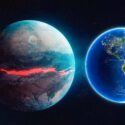Scientists have pieced together a pretty clear picture of what life was like on Earth thousands, even millions of years ago. If you fast-forward one million years from now, would an alien civilization be doing the same to learn about us? What would Earth look like one million years from now? What remains of human civilization would still be around? And would we end up as clones in a human version of Jurassic Park?
We’re living in the Anthropocene epoch. And in this historical period, the human impact on the world around us has been significant enough to geologically alter it. One hundred years from now, it could be an era defined by ecological collapse and mass extinction. A big bummer, right? There’s no way for us to know how and when our species may take its final walk on our home planet.
A team of alien scientists could find evidence of nuclear fallout, climate change or maybe a massive asteroid that ended our existence. Or maybe they’d even find us already living on another planet. One million years from now, you’d be an alien on board a starship that has just entered into orbit around Earth. Despite your best efforts to scan the planet below for intelligent life, you’d find nothing.
Your trip down to the surface would be slightly delayed by an ongoing supervolcanic eruption. The planet would be blanketed in the darkness of ash. You might have to wait a few years for your alien crew to clean it up before you could even land. Finally, you’d get approval to visit Earth. Down there you’d find everything to be barren and lifeless.
Storms, fires and earthquakes would have erased nearly all signs of immediately visible life. But your team of archaeologists and paleontologists would know that if they wanted to find evidence of past civilizations, they’d better start digging. You’d be investigating what are called boundary layers. These are geological signatures that indicate a transition from one period to the next.
So you’d be looking for animal and plant fossils, as well as changes in rock layers. You could find a thin layer of clay that marks the boundary to our Anthropocenic era. The top layer would contain not much more than small fossilized remains of a few plant species. The layer below would contain older rock. But not only that, there would be an abundance of diverse plant fossils.
This would be a breakthrough for your team as they’d now confirm there was some form of mass extinction period. As you searched through this layer, the nature of what happened to Earth over the past million years would be revealed. You’d discover an unnatural amount of carbon deposits from fossil fuel emissions. Evidence of global temperature changes. And widespread chemical pollutants.
But the effects of climate change may have reversed themselves over the nearly one million years humans have been absent. If your team were to uncover the regions where our coastal populations used to be, you could excavate the remains of cities relatively well preserved in the sedimentary rock. Imagine discovering the ancient subway tunnels and sewers of New York. But nothing you’d find would be in pristine condition.
Bricks would have gone from their characteristic red to gray. And steel would have rusted and dissolved, leaving only imprints in the soil. Finally, you’d make the biggest discovery of all. Fossilized human bones. Just like the dinosaurs, these too would most likely only be found encased in sedimentary rock. Almost all the fossils of dinosaurs that we discover today are from species that would have lived near lakes or rivers that flooded.
Floods covered their remains in mud and silt very quickly. And this prevented their bones from rotting. The same would apply to Homo sapiens. Your alien team would piece together the puzzle that many of these human fossils were the result of catastrophic floods or tsunamis. And based on how much these bones have fused with the rocks around them, your team could start to assemble a timeline of our unfortunate human demise.
Usually, bones take decades to decompose. If buried in a dry environment, like a funeral casket, they could last for one hundred years. Mummified bones can survive for thousands of years. Finding any of these would tell your team that the last humans to walk the Earth weren’t all that far in the past. But discovering only fossilized remains would reveal our extinction point being further back than you’d hoped.
There wouldn’t be any samples of soft tissues, like muscles. Just rocks that used to be bones. Oh, but you’d probably find fossilized plastic in the layers of sedimentary rock too. It’s not yet known how long plastic waste needs to decompose into organic matter. It could take hundreds of years. Maybe thousands. Or as you and your crew could discover, millions.
What you’d keep your hopes up for would be the real holy grail, human DNA. The oldest samples found in our modern times date back 800,000 years and come from insects and plants. But studies conclude that DNA could take about 7 million years to disintegrate. And eureka. You’d find human DNA samples trapped in ice cores in what was once Greenland.
The big question would be, what do you do with them? Study human genetics for scientific purposes, or have a little fun? One idea would be to clone these ancient humans. You could even create some kind of Jurassic Park filled with people. Except this would be called Anthropocene Park. And based on all that you’d put together about our tragic history, there would be so many entertaining things to do in this amusement park.
Maybe you could clone other animals and play a game of mass extinction. The winner would be who could kill the most species in the shortest amount of time. You could dig for hidden oil reserves. Increase carbon emissions for fun to watch the icebergs melt. Or how about a game of nuclear war? Sadly though, you and the other alien scientists probably wouldn’t be able to figure out what life was like for humans at the end of our civilization.
Sources
- “Here’s A Mind-Melting Snapshot Of What Earth Will Look Like In 1 Billion Years”. Fiona MacDonald. 2017. sciencealert.com.
- “Asteroid Impact – The Global Challenges Foundation”. 2022. globalchallenges.org.
- “Why Some Dinosaur Bones Last So Long – Adventure Dinosaurs”. Michael Haralson. 2021. adventuredinosaurs.com.
- “Dinosaur Bones”. 2022. amnh.org.
- “How Are Dinosaur Fossils Formed?”. Lisa Hendry. 2022. nhm.ac.uk.



























